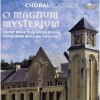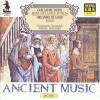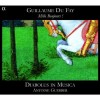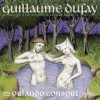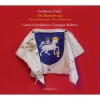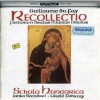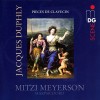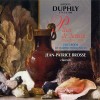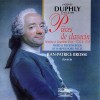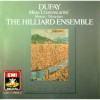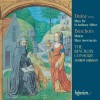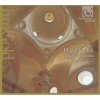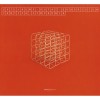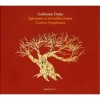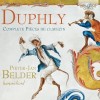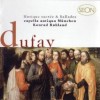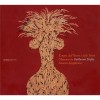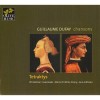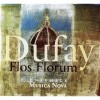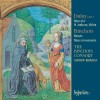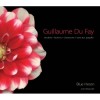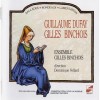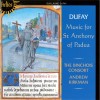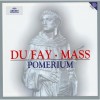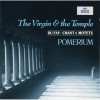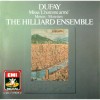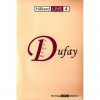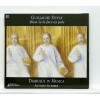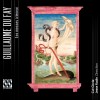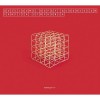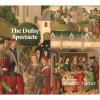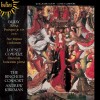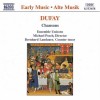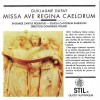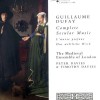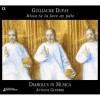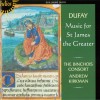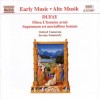| Country: | Netherlands |
| Period: | Middle Ages, Renaissance |
Biography
Guillaume Dufay (French pronunciation: [dyfɛ]; also Du Fay, Du Fayt; August 5, c. 1397[1] – November 27, 1474) was a Franco-Flemish composer of the early Renaissance. As the central figure in the Burgundian School, he was the most famous and influential composer in Europe in the mid-15th century.
From the evidence of his will, he was probably born in Beersel, in the vicinity of Brussels. He was the illegitimate child of an unknown priest and a woman named Marie Du Fayt.[2] Marie moved with her son to Cambrai early in his life, staying with a relative who was a canon of the cathedral there. Soon Dufay's musical gifts were noticed by the cathedral authorities, who evidently gave him a thorough training in music; he studied with Rogier de Hesdin during the summer of 1409, and he was listed as a choirboy in the cathedral from 1409 to 1412. During those years he studied with Nicolas Malin, and the authorities must have been impressed with the boy's gifts because they gave him his own copy of Villedieu’s Doctrinale in 1411, a highly unusual event for one so young. In June 1414, at the age of only 16, he had already been given a benefice as chaplain at St. Géry, immediately adjacent to Cambrai. Later that year he probably went to the Council of Konstanz, staying possibly until 1418, at which time he returned to Cambrai.
From November 1418 to 1420 he was a subdeacon at Cambrai Cathedral. In 1420 he left Cambrai again, this time going to Rimini, and possibly Pesaro, where he worked for the Malatesta family. Although no records survive of his employment there, several compositions of his can be dated to this period; they contain references that make a residence in Italy reasonably certain. It was there that he met the composers Hugo and Arnold de Lantins, who were among the musicians of the Malatesta household. In 1424 Dufay again returned to Cambrai, this time because of the illness and subsequent death of the relative with whom his mother was staying. By 1426, however, he had gone back to Italy, this time to Bologna, where he entered the service of Cardinal Louis Aleman, the papal legate. While in Bologna he became a deacon, and by 1428 he was a priest. Cardinal Aleman was driven from Bologna by the rival Canedoli family in 1428, and Dufay also left at this time, going to Rome. He became a member of the Papal Choir, serving first Pope Martin V, and then after the death of Pope Martin in 1431, Pope Eugene IV. In 1434 he was appointed maistre de chappelle in Savoy, where he served Duke Amédée VIII; evidently he left Rome because of a crisis in the finances of the papal choir, and to escape the turbulence and uncertainty during the struggle between the papacy and the Council of Basel. Yet in 1435 he was again in the service of the papal chapel, but this time it was in Florence—Pope Eugene having been driven from Rome in 1434 by the establishment of an insurrectionary republic there, sympathetic to the Council of Basel and the Conciliar movement. In 1436 Dufay composed the festive motet Nuper rosarum flores, one of his most famous compositions, which was sung at the consecration of the cathedral in Florence, while Eugene lived in exile in the city at the nearby church of Santa Maria Novella.
During this period Dufay also began his long association with the Este family in Ferrara, some of the most important musical patrons of the Renaissance, and with which he probably had become acquainted during the days of his association with the Malatesta family; Rimini and Ferrara are not only geographically close, but the two families were related by marriage, and Dufay composed at least one ballade for Niccolò III, Marquis of Ferrara. In 1437 Dufay visited the town. When Niccolò died in 1441, the next Marquis maintained the contact with Dufay, and not only continued financial support for the composer but copied and distributed some of his music.
The struggle between the papacy and the Council of Basel continued through the 1430s, and evidently Dufay realised that his own position might be threatened by the spreading conflict, especially since Pope Eugene was deposed in 1439 by the Council and replaced by Duke Amédée of Savoy himself, as Pope (Antipope) Felix V. At this time Dufay returned to his homeland, arriving in Cambrai by December of that year. In order to be a canon at Cambrai, he needed a law degree, which he obtained in 1437; he may have studied at University of Turin in 1436. One of the first documents mentioning him in Cambrai is dated December 27, 1440, when he received a delivery of 36 lots of wine for the feast of St. John the Evangelist.
Dufay was to remain in Cambrai through the 1440s, and during this time he was also in the service of the Duke of Burgundy. While in Cambrai he collaborated with Nicolas Grenon on a complete revision of the liturgical musical collection of the cathedral, which included writing an extensive collection of polyphonic music for services. In addition to his musical work, he was active in the general administration of the cathedral. In 1444 his mother Marie died, and was buried in the cathedral; and in 1445 Dufay moved into the house of the previous canon, which was to remain his primary residence for the rest of his life.
After the abdication of the last antipope (Felix V) in 1449, his own former employer Duke Amédée VIII of Savoy, the struggle between different factions within the Church began to heal, and Dufay once again left Cambrai for points south. He went to Turin in 1450, shortly before the death of Duke Amédée, but returned to Cambrai later that year; and in 1452 he went back to Savoy yet again. This time he did not return to Cambrai for six years, and during that time he attempted to find either a benefice or an employment which would allow him to stay in Italy. Numerous compositions, including one of the four Lamentationes that he composed on the Fall of Constantinople in 1453, his famous mass based on Se la face ay pale, as well as a letter to Lorenzo de' Medici, survive from this period: but as he was unable to find a satisfactory position for his retirement, he returned north in 1458. While in Savoy he served more-or-less officially as choirmaster for Louis, Duke of Savoy, but he was more likely in a ceremonial role, since the records of the chapel never mention him.
When he returned to Cambrai for his final years, he was appointed canon of the cathedral. He was now the most renowned composer in Europe.[3] Once again he established close ties to the court of Burgundy, and continued to compose music for them; in addition he received many visitors, including Busnois, Ockeghem, Tinctoris, and Loyset Compère, all of whom were decisive in the development of the polyphonic style of the next generation. During this period he probably wrote his mass based on L'homme armé, as well as the chanson on the same song; the latter composition may have been inspired by Philip the Good's call for a new crusade against the Turks, who had recently captured Constantinople. He also wrote a Requiem mass around 1460, which is lost.
After an illness of several weeks, Dufay died on November 27, 1474. He had requested that his motet Ave regina celorum be sung for him as he died, with pleas for mercy interpolated between verses of the antiphon, but time was insufficient for this to be arranged. Dufay was buried in the chapel of St. Étienne in the cathedral of Cambrai; his portrait was carved onto his tombstone. After the destruction of the cathedral the tombstone was lost, but it was found in 1859 (it was being used to cover a well), and is now in the Palais des Beaux Arts museum in Lille.
Dufay was the most influential composer of the 15th century, and his music was copied, distributed and sung everywhere that polyphony had taken root. Almost all composers of the succeeding generations absorbed some elements of his style. The wide distribution of his music is all the more impressive considering that he died decades before the availability of music printing.
He composed in most of the common forms of the day, including masses, motets, Magnificats, hymns, simple chant settings in fauxbourdon, and antiphons within the area of sacred music, and rondeaux, ballades, virelais and a few other chanson types within the realm of secular music. None of his surviving music is specifically instrumental, although instruments were certainly used for some of his secular music, especially for the lower parts; all of his sacred music is vocal. Instruments may have been used to reinforce the voices in actual performance for almost any of his works. Seven complete Masses, 28 individual Mass movements, 15 settings of chant used in Mass propers, three Magnificats, two Benedicamus Domino settings, 15 antiphon settings (six of them Marian antiphons), 27 hymns, 22 motets (13 of these isorhythmic in the more angular, austere 14th-century style which gave way to more melodic, sensuous treble-dominated part-writing with phrases ending in the "under-third" cadence in Dufay's youth) and 87 chansons definitely by him have survived. But attributing works of questionable authorship to Dufay based on alleged stylistic similarities has been a favorite pastime of musicologists for at least a hundred years, judging from the copious literature on the subject.
Many of Dufay's compositions were simple settings of chant, obviously designed for liturgical use, likely as substitutes for the unadorned chant, and can be seen as chant harmonizations. Often the harmonization used a technique of parallel writing known as fauxbourdon, as in the following example, a setting of the Marian antiphon Ave maris stella
Dufay may have been the first composer to use the term "fauxbourdon" for this simpler compositional style, prominent in 15th century liturgical music in general and that of the Burgundian school in particular.
Most of Dufay's secular songs follow the formes fixes (rondeau, ballade, and virelai), which dominated secular European music of the 14th and 15th centuries. He also wrote a handful of Italian ballate, almost certainly while he was in Italy. As is the case with his motets, many of the songs were written for specific occasions, and many are datable, thus supplying useful biographical information.
Most of his songs are for three voices, using a texture dominated by the highest voice; the other two voices, unsupplied with text, were likely played by instruments. Occasionally Dufay used four voices, but in a number of these songs the fourth voice was supplied by a later, usually anonymous, composer. Typically he used the rondeau form when writing love songs. His latest secular songs show influence from Busnois and Ockeghem, and the rhythmic and melodic differentiation between the voices is less; as in the work of other composers of the mid-15th century, he was beginning to tend towards the smooth polyphony which was to become the predominant style fifty years later.
A typical ballade is Resvellies vous et faites chiere lye, which was written in 1423 for the marriage of Carlo Malatesta and Vittoria di Lorenzo Colonna[4] (Carlo was a son of Malatesta dei Sonetti, Lord of Pesaro. Vittoria was the niece of Pope Martin V).[5] The musical form is aabC for each stanza, with C being the refrain. The musical setting emphasizes passages in the text which specifically refer to the couple being married.
Two written works by Dufay have been documented, but neither has survived. A note in the margin in a manuscript held in the Biblioteca Nazionale Palatina in Parma refers to a Musica which he wrote; no copy of the work itself has been found. Nineteenth-century musicologist François-Joseph Fétis claimed to have seen a sixteenth-century copy of a Tractatus de musica mensurata et de proportionibus by Dufay, last seen in a bookshop in London in 1824. The contents of neither work are known.
Dufay was one of the last composers to make use of late-medieval polyphonic structural techniques such as isorhythm,[7] and one of the first to employ the more mellifluous harmonies, phrasing and melodies characteristic of the early Renaissance.[8] His compositions within the larger genres (masses, motets and chansons) are mostly similar to each other; his renown is largely due to what was perceived as his perfect control of the forms in which he worked, as well as his gift for memorable and singable melody. During the 15th century he was universally regarded as the greatest composer of his time, an opinion that has largely survived to the present day.
The early music ensemble Dufay Collective is named after him.







